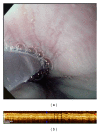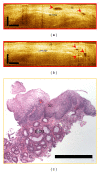Endoscopic Optical Coherence Tomography (OCT): Advances in Gastrointestinal Imaging
- PMID: 24719611
- PMCID: PMC3955614
- DOI: 10.1155/2014/376367
Endoscopic Optical Coherence Tomography (OCT): Advances in Gastrointestinal Imaging
Abstract
In the rapidly evolving field of endoscopic gastrointestinal imaging, Optical Coherence Tomography (OCT) has found many diverse applications. We present the current status of OCT and its practical applications in imaging normal and abnormal mucosa in the esophagus, stomach, small and large intestines, and biliary and pancreatic ducts. We highlight technical aspects and principles of imaging, assess published data, and suggest future directions for OCT-guided evaluation and therapy.
Figures




References
-
- Song LM, Adler DG, Conway JD, et al. Narrow band imaging and multiband imaging. Gastrointestinal Endoscopy. 2008;67(4):581–589. - PubMed
-
- Neumann H, Kiesslich R, Wallace MB, Neurath MF. Confocal laser endomicroscopy: technical advances and clinical applications. Gastroenterology. 2010;139(2):388.e2–392.e2. - PubMed
-
- Tearney GJ, Brezinski ME, Southern JF, Bouma BE, Boppart SA, Fujimoto JG. Optical biopsy in human gastrointestinal tissue using optical coherence tomography. American Journal of Gastroenterology. 1997;92(10):1800–1804. - PubMed
Publication types
LinkOut - more resources
Full Text Sources
Other Literature Sources

